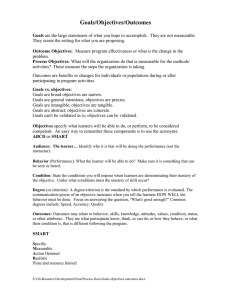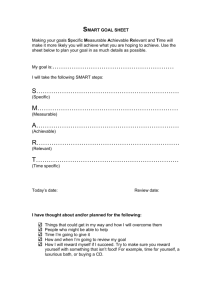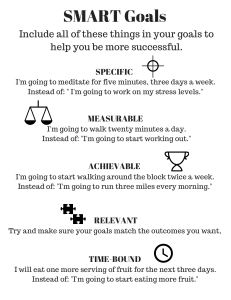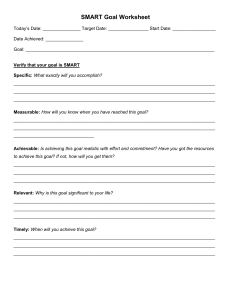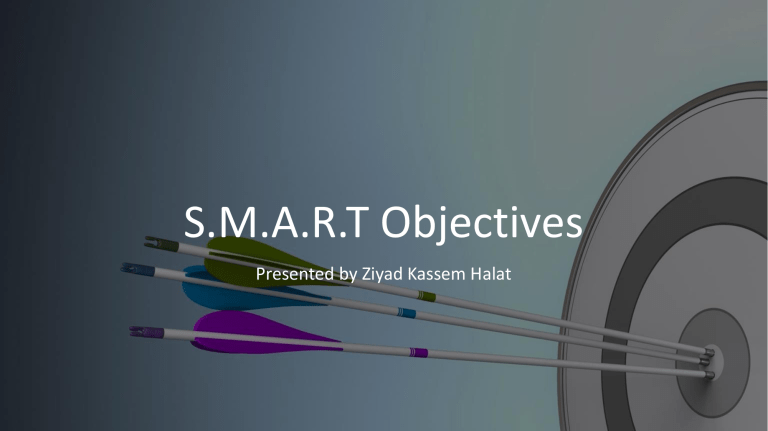
S.M.A.R.T Objectives Presented by Ziyad Kassem Halat My message I believe it’s an excellent idea to prepare the teachers to set positive goals. Schools should introduce concepts like SMART goals as a way of gradually building teachers’ capacity to tackle the increasing challenges they are facing. Defining “Learning Objective” • A learning objective is a description of what the learner must be able to do upon completion of an educational activity. A well-written learning objective outlines the knowledge, skills and/or attitude the learners will gain from the educational activity and does so in a measurable way. • An effective learning objective should include the following 5 elements: who, will do, how much or how well, of what, by when. The mnemonic SMART— Specific, Measurable, Attainable, Relevant, and Timebound—can be used to describe the elements of a well-written learning objective. Practical tips for writing effective learning objectives • Since the point of a learning objective is to describe the intended outcome for learning, begin the learning objective with: “Upon completion of this educational activity, learners should be able to . . . .” The next step is to identify the concepts the learners need to learn and how they will demonstrate their understanding. It is recommended that the teacher choose one action verb that is measurable and observable. Verbs such as understand, know, learn, appreciate, believe, be familiar with, comprehend, and so on, are not observable or measurable and should be avoided. Each learning objective must be separate; two actions (such as diagnosis and management) must not be combined. It is also important that the action verb identify the level and cognitive domain at which the learner is expected to perform. Bloom's Taxonomy connects the depth of learning with action verbs that may be used when writing learning objectives. Effective Lesson Planning begins with S.M.A.R.T objectives Lesson objectives should be specific, measurable, achievable, relevant, and time-bound. First, it should be specific. It answers the questions “what is to be done?”, “How will you know it is done” and "describes the result of the work to be done.” Second, it should be measurable. It answers the questions “how will you know it meets the expectation”. Effective lesson planning begins with S.M.A.R.T objectives Third, it should be achievable. It answers the questions “can the student do it?” Fourth, it should be relevant. It answers the questions “should it be done” and “why?” And lastly, lesson objectives should have a time-bound. It answers the questions “when will it be done”. Developing a SMART Goal Specific: Use clear, direct language to tell the learner exactly what he or she should learn and what he should be able to do after the training. Don't be vague, unclear, or misleading. Measurable: The point of setting a learning objective is to determine if the learner can meet, perform, or satisfy it. And you can only do that if the objective is something that you can measure. A common mistake of using words like "know" or "understand," which are not actions that can be objectively observed Developing a SMART Goal Achievable: Your learning objective must be something your learners have a chance of completing/satisfying. They must have enough pre-existing knowledge, time, and similar resources. Relevant: The objective should be something the learner sees the value in learning. Timely: A learning objective should include a specific date (or point in the course) by which it will be completed. It is important to allow enough time to successfully implement the steps needed to achieve the objective, but not so much as to elicit procrastination Frame Goals As SMART Goals Learning how to frame goals as SMART goals and being willing to adjust them to get SMARTer is an important skill that can help every teacher get off to a better start and have a better school year, this year and into the future. Do Learning Objectives Add Value to Curriculum and Assessment? • For many, writing out the learning objectives appears to be an effort to its own end. However, learning objectives are the foundation for instructional alignment. Instructional alignment means that learning objectives, assessment tools, and instructional methods mutually support the same educational outcome. This is known as the Golden Triangle
